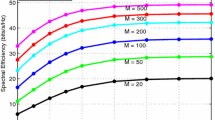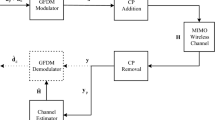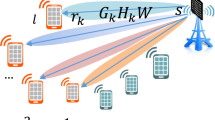Abstract
Massive multiple-input and multiple-output (MIMO) schemes involving several tens or even hundreds of antenna elements are pointed as one of the key technologies for 5G systems. However the huge capacity gains attainable by these schemes, are only possible with receivers able to cope with the frequency selective fading that may affect the signals. These systems can be combined with single-carrier with frequency domain equalization (SC-FDE) schemes to improve the power efficiency in uplink due to the low envelope fluctuations. However, when more antennas are involved in the communication link, channel matrix size grows and the complexity involved in equalization process can be an obstacle to power consumption and low latency. In this paper we will focus on the equalization applied in massive MIMO schemes, more specifically in two new low complexity receivers based on an iterative block decision feedback equalizer (IB-DFE) that avoid matrix inversion operation by replacing in the equalizer the feedforward part by an equal gain combiner (EGC) or a maximum ratio combiner (MRC) module.









Similar content being viewed by others
References
Pi, Z., & Khan, F. (2011). An introduction to millimeter-wave mobile broadband systems. IEEE Communications Magazine, 49(6), 101–107.
Boccardi, F., Heath, R., Lozano, A., Marzetta, T., & Popovski, P. (2014). Five disruptive technology directions for 5G. IEEE Communications Magazine, 52(2), 74–80.
Han, S., Xu, C.I.Z., & Rowell, C. (2015). Large-scale antenna systems with hybrid analog and digital beamforming for millimeter wave 5G. IEEE Communications Magazine, 53(1), 186–194.
Alkhateeb, A., Mo, J., Gonzlez-Prelcic, N., & Heath, R.W. (2014). MIMO precoding and combining solutions for millimeter-wave systems. IEEE Communications Magazine, 52(12), 122–131.
Rusek, F., Persson, D., Lau, B. K., Larsson, E.G., Edfors, O., Tufvesson, F., & Marzetta, T.L. (2013). Scaling up MIMO: opportunities and challenges with very large arrays. IEEE Signal Processessing Magazine, 30(1), 40–60.
Coon, J.P., & Beach, M.A. (2002). An investigation of MIMO single-carrier frequency-domain MMSE equalization. In Proceedings of London Communications Symposium (pp. 237–240).
Falconer, D., Ariyavisitakul, S., Benyamin-Seeyar, A., & Eidson, B. (2002). Frequency domain equalization for single-carrier broadband wireless systems. IEEE Communications Magazine, 4(4), 58–66.
Gusmão, A., Dinis, R., Conceicão, J., & Esteves, N. (2000). Comparison of two modulation choices for broadband wireless communications, IEEE VTC2000(Spring), vol. 2.
Silva1, J.C., Dinis, R., Souto, N., & Marques da Silva, M. (2013). MIMO SC-FDE transmission techniques with channel estimation and high-order modulations. In Proceedings Progress In Electromagnetics Research Symposium, Taipei.
Borges, D., Montezuma, P., & Dinis, R. (2016). Low complexity MRC and EGC based receivers for SC-FDE modulations with massive MIMO schemes. In 2016 IEEE GlobalSip, Washington, DC, USA.
Silva, P., & Dinis, R. (2012). Frequency-domain multiuser detection for CDMA systems. Aalborg: River Publishers.
Dinis, R., Montezuma, P., Souto, N., & Silva, J. (2010). Iterative frequency-domain equalization for general constellations. Princeton: IEEE Sarnoff Symposium.
Benvenuto, N., & Tomasin, S. (2002). Block iterative DFE for single carrier modulation. Electronics Letters, 39(19), 1144–1145.
Dinis, R., Kalbasi, R., Falconer, D., & Banihashemi, A. (2004). Iterative layered space-time receivers for single-carrier transmission over severe time-dispersive channels. IEEE Communications Letters, 8(9), 579–581.
Benvenuto, N., Dinis, R., Falconer, D., & Tomasin, S. (2010). Single carrier modulation with nonlinear frequency domain equalization: An idea whose time has come - again. Proceedings of the IEEE, 98(1), 69–96.
Silva, F., Dinis, R., & Montezuma, P. (2011). Estimation of the feedback reliability for IB-DFE receivers, ISRN Communications and Networking, vol. 2011, Article No. 30.
Hunger, R. (2007). Floating Point Operations in Matrix-Vector Calculus, Munich University of Technology. Technical Report, V(1), 3.
Acknowledgments
This work was supported in part by CTS multi-annual funding project PEst-OE/EEI/UI0066/2011,IT UID/EEA/ 50008/2013 (plurianual founding and project GLANCES), EnAcoMIMOCo EXPL/EEI-TEL/2408/2013 and UID/EEA/50008/2013 - MM5G.
Author information
Authors and Affiliations
Corresponding author
Rights and permissions
About this article
Cite this article
Borges, D., Montezuma, P., Ferreira, A. et al. Two Low Complexity MRC and EGC Based Receivers for SC-FDE Modulations with Massive MIMO Schemes. J Sign Process Syst 90, 1357–1367 (2018). https://doi.org/10.1007/s11265-018-1335-1
Received:
Revised:
Accepted:
Published:
Issue Date:
DOI: https://doi.org/10.1007/s11265-018-1335-1




